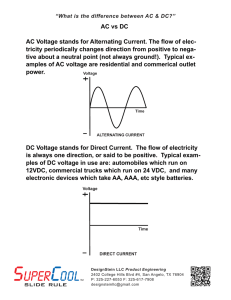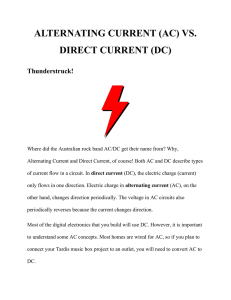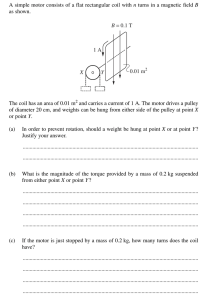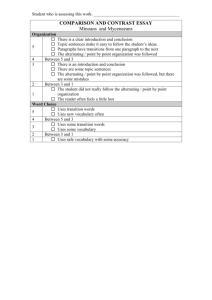End of chapter exercises
advertisement
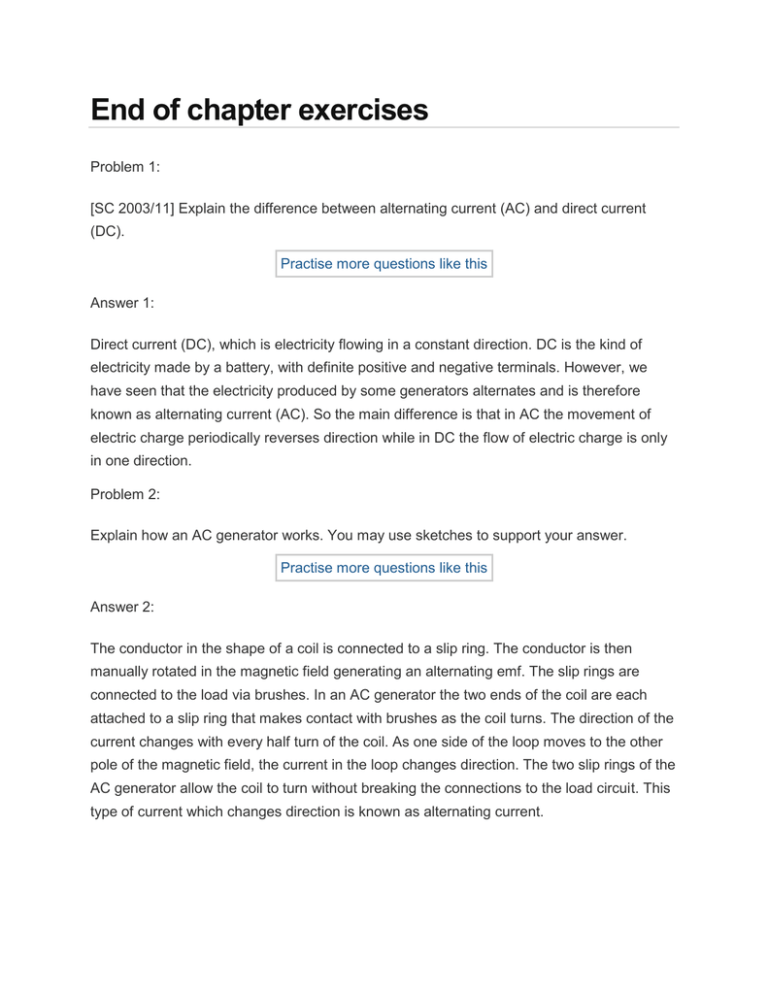
End of chapter exercises Problem 1: [SC 2003/11] Explain the difference between alternating current (AC) and direct current (DC). Practise more questions like this Answer 1: Direct current (DC), which is electricity flowing in a constant direction. DC is the kind of electricity made by a battery, with definite positive and negative terminals. However, we have seen that the electricity produced by some generators alternates and is therefore known as alternating current (AC). So the main difference is that in AC the movement of electric charge periodically reverses direction while in DC the flow of electric charge is only in one direction. Problem 2: Explain how an AC generator works. You may use sketches to support your answer. Practise more questions like this Answer 2: The conductor in the shape of a coil is connected to a slip ring. The conductor is then manually rotated in the magnetic field generating an alternating emf. The slip rings are connected to the load via brushes. In an AC generator the two ends of the coil are each attached to a slip ring that makes contact with brushes as the coil turns. The direction of the current changes with every half turn of the coil. As one side of the loop moves to the other pole of the magnetic field, the current in the loop changes direction. The two slip rings of the AC generator allow the coil to turn without breaking the connections to the load circuit. This type of current which changes direction is known as alternating current. Problem 3: What are the advantages of using an AC motor rather than a DC motor. Practise more questions like this Answer 3: While DC motors need brushes to make electrical contact with moving coils of wire, AC motors do not. The problems involved with making and breaking electrical contact with a moving coil are sparking and heat, especially if the motor is turning at high speed. If the atmosphere surrounding the machine contains flammable or explosive vapours, the practical problems of spark-producing brush contacts are even greater. Problem 4: Explain how a DC motor works. Practise more questions like this Answer 4: Instead of rotating the loops through a magnetic field to create electricity, as is done in a generator, a current is sent through the wires, creating electromagnets. The outer magnets will then repel the electromagnets and rotate the shaft as an electric motor. If the current is DC, split-ring commutators are required to create a DC motor. Problem 5: At what frequency is AC generated by Eskom in South Africa? Practise more questions like this Answer 5: In South Africa the frequency is 50 Hz Problem 6: (IEB 2001/11 HG1) - Work, Energy and Power in Electric Circuits Mr. Smith read through the agreement with Eskom (the electricity provider). He found out that alternating current is supplied to his house at a frequency of 50 Hz. He then consulted a book on electric current, and discovered that alternating current moves to and fro in the conductor. So he refused to pay his Eskom bill on the grounds that every electron that entered his house would leave his house again, so therefore Eskom had supplied him with nothing! Was Mr. Smith correct? Or has he misunderstood something about what he is paying for? Explain your answer briefly. Practise more questions like this Answer 6: Mr Smith is not correct. He has misunderstood what power is and what Eskom is charging him for. AC voltage and current can be described as: iv=Imaxsin(2πft+ϕ)=Vmaxsin(2πft) This means that for ϕ=0, i.e. if resistances have no complex component or if a student uses a standard resistor, the voltage and current waveforms are in-sync. Power can be calculated as P=VI. If there is no phase shift, i.e. if resistances have no complex component or if a student uses a standard resistor then power is always positive since: when the voltage is negative (−), the current is negative (−), resulting in positive (+) power. when the voltage is positive (+), the current is positive (+), resulting in positive (+) power. Problem 7: You are building a laser that takes alternating current and it requires a very high peak voltage of 180 kV. By your calculations the entire laser setup can be treated at a single resistor with an equivalent resistance of 795 ohms. What is the rms value for the voltage and the current and what is the average power that your laser is dissipating? Practise more questions like this Answer 7: At peak voltage the peak current will be: VI=IR=VR=180×103795=226,42 A Prms=VrmsIrms=180×1032√226,4150942√=20,38×106 W 20,38 × 106 W
